

Every vine feels their touch.
Twenty-five years ago Gary Franscioni planted his first vineyard in the Santa Lucia Highlands. Longtime friend Gary Pisoni, Nicky Hahn, and a few other pioneers were starting to make noise growing Pinot Noir in the region. The Franscioni family had a long farming history in the Salinas Valley, most of it in row crops. Gary Franscioni shifted that focus to viticulture. His mission was to grow top shelf wine.
Today Gary Franscioni's family meticulously farms four premier vineyards in the Santa Lucia Highlands. The focus is on quality. They firmly believe that premium grapes are needed to make premium wines. A small team of dedicated workers puts boots on the ground every day. Each vine and cluster at Rosella's Vineyard, Garys' Vineyard, Soberanes Vineyard, and Sierra Mar Vineyard is touched every twelve to fourteen days. Think about that. There are a lot of vines in one hundred eighty acres.
Twenty years ago Gary and Rosella Franscioni launched ROAR Wines to immediate acclaim. They are now joined by sons Adam and Nick in the pursuit of Pinot Noir, Chardonnay, and Syrah perfection. The siblings represent the fourth generation of Franscioni farmers in the Salinas Valley. Both are well aware of the responsibilities inherent with a family business, tradition, and legacy. Enjoy our discussion about those topics and all things ROAR Wines and Santa Lucia Highlands.
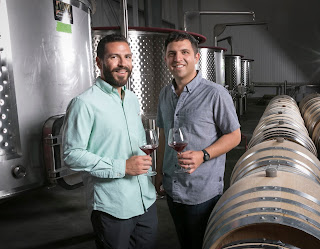 Nick & Adam Franscioni
Nick & Adam Franscioni

The Wine Write: You father, Gary Franscioni, is a third generation farmer there, but shifted his focus toward wine grapes. What gave him the prescience to do that in the Santa Lucia Highlands?
Nick: There were a number of factors. Gary Pisoni is a life long friend. He had gotten things going here, and had picked up a lot of steam growing grapes for wineries in the area. Dad saw Nicky Hahn performing really well here. Dad was starting to get away from the row crop side of the business. That shift in the farming landscape, along with the potential for what grapevines had to offer, were two important things. He had also gotten into tasting and enjoying wine. That played into his decision, too. Dad likes to trial and error things. He's not a guy who goes and plants a hundred acres of something. He'll plant a five acre parcel and see if it works. That's really how he got started.
Adam: Dad was a food science major at Cal Poly-San Luis Obispo. His class took a field trip up to Napa to look at wineries and grape growing. He really loved that. It was a new experience for him. There wasn't a lot of white tablecloth in this region when he was growing up. Seeing that atmosphere in Napa excited him. I think the idea of winding up in viticulture was planted in his mind then. If you're farming row crops, you need thousands of acres of land to make any money. We had eighty acres in the valley and about one hundred fifty acres on our property. That wasn't enough acreage to farm row crops. Dad would save money every year so that he could eventually build a vineyard. That's a nice lesson for us. Because it's so expensive to plant a vineyard, he did it in sections as he could afford it.
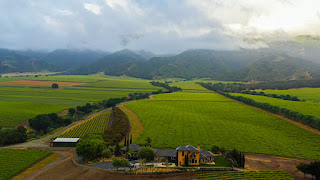 Rosella's Vineyard, planted in 1996
Rosella's Vineyard, planted in 1996
The Wine Write: Now we know how well suited the Santa Lucia Highlands is for Pinot Noir, Chardonnay, and Syrah, but was there a lot of experimentation when he started?
Adam: I think Cabernet Sauvignon was really popular at the beginning. Chardonnay was here from the start. Sauvignon Blanc was, too. All of those varieties did well in Napa, so the thought was to grow them here. The Bordeaux varietals didn't do so well. Gary Pisoni, Nicky Hahn, and others had the foresight to assert that this was a Pinot Noir spot. There was a point in the Seventies and Eighties when winemakers from Napa were coming down to plant Chardonnay cheaply here. They used that fruit in their Napa wines.
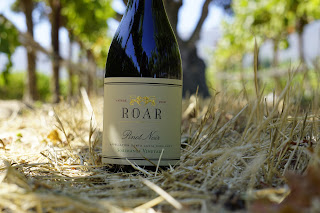
The Wine Write: How did the idea of starting ROAR come about?
Nick: Dad was selling fruit to Morgan, Bernardus, and a few other local wineries. He saw how well those wines showed, and wondered why he couldn't do the same thing. Dad likes to do business ventures. He and Mom decided to create this brand. The whole idea was to make wines that the two of them loved to drink. I think his success with grape growing sort of naturally led to starting a winery.
Adam: One of the things I really appreciate about him is his thirst for knowledge. Dad is a great farmer. I don't think he initially understood everything that was discussed on the winemaking side. I don't think he started a winery simply to learn that side of the business, but he did pick up that knowledge in the process. That knowledge helped him to be even a better farmer. He could see the entire process at that point. That helped him tailor some of our farming practices. ROAR became a huge success.
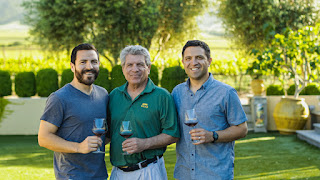 The Franscioni brothers, joined by father Gary
The Franscioni brothers, joined by father Gary
The Wine Write: Both of you did some other things vocationally before you returned to the family business. Can you talk about that, and how you found happiness in the wine business?
Adam: I was in a nine-to-five job and wasn't really loving it. I wanted to travel some. I knew wine could give me those experiences, especially with Southern Hemisphere harvests taking place in our springtime. That was part of it. I also wanted my own hours. We used to make the wine in San Francisco, so I lived there. When we built the winery in Monterey, I moved down there. I fell more and more in love with our region and its beauty. Being outside was also a big draw. It sure beats being cooped up in an office all day.
Nick: We both worked summers in the vineyards during high school. That was a lot of tedious, tiresome labor. I think Dad gave us some tough jobs to give us a sense of the work. We moved pipe in the row crop fields. That's dirty work. We worked in the vineyards pulling leaves and trimming the wings off clusters. We got a real understanding of vineyard work. We grew up around this environment our whole life. There are a lot of farming families in our community. It's the only thing we really knew back then. As I grew up, I had an attraction for living in a bigger city. I thought I'd like the hustle and bustle. You don't realize what you have until it's gone sometimes. So I went to USC for business studies. Going to Cal Poly for viticulture would have made more sense, but that's not the path I took. I wanted that bigger school and bigger city environment.
I actually loved college. I then worked in consulting for about three years. I realized I could stay in the rat race and climb the ladder, or I could work in a family business and carry on with the wonderful assets my dad has. I had to choose directions. It seemed like a simple decision. There was a natural calling to come home and study at the University of Gary Franscioni. We're both getting masters degrees here now from a top professor.
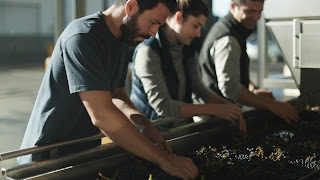
The Wine Write: Do each of you concentrate on a different aspect of the business?
Adam: It's more like we'll do whatever is necessary. If something is there to get done, we'll get it done. I am assisting my dad more on the viticulture side. We always need someone here on the ranch. On any given day we can have up to eighty-five people working on all of the ranches. That includes the farming of grapes, lemons, and avocados. It can get very busy. A lot of stuff is happening. We need someone to manage all that.
The Wine Write: You're privileged to have a group of long term, highly trained employees.
Adam: That's right. Those people are great assets to us. Many of them are very, very skilled and have worked for us for ten to twenty years. Having that continuity is incredibly important. That's been huge for us. I think that can get overlooked at times. We have a very stable workforce. They know how meticulous we are. At this point we can just tell the head guy what we want done. With that one message, the work gets done. It's a well oiled machine at this point. It's so nice to have a stable, steady workforce.
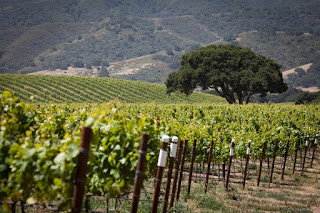 Soberanes Vineyard, planted 2008
Soberanes Vineyard, planted 2008
The Wine Write: What are the biggest challenges you face in growing grapes in the Santa Lucia Highlands?
Adam: The weather. Pinot Noir is really susceptible to botrytis and powdery mildew. Those pests are our biggest issues. We are diligent in canopy management. We allow a lot of air flow. A lot of hand labor is involved. Someone is touching our vines every twelve to fourteen days. That's quite a bit of work when you are farming one hundred eighty acres.
We're concerned about the drought every year. We need our fourteen inches of rain annually. This winter we only got eight. Our wells are still running fine now. We'll test them again in the fall, after our growing season. We are very fortunate to have the Salinas River here. A lot of it runs underground and feeds us from the south. I think it's the longest underground river in this country. It's a wealth of resources for us. We are competing against a lot of row crop farmers for water resources here.
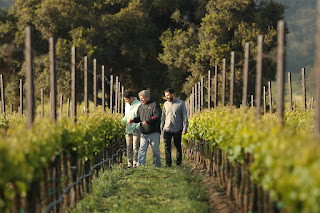
The Wine Write: Your afternoon winds are a defining feature of the Santa Lucia Highlands. Are they a benefit or a hindrance to grape farming?
Nick: Those winds are very beneficial, no doubt about it. Typically those will kick up in the late afternoon. They give us great aeration. They also shut down the vines a bit earlier, maybe an hour or two early. They help with the overall extension of the growing season. We probably get two or three more weeks on the vines because of the winds. We have one of the longest growing seasons in California. That does mean more work for us.
The longer growing season gives us a bigger window. There's more time to pick and choose when you want to harvest for the style of your wine. You have some people who pick at twenty-three or twenty-four brix. That will give you a lighter complexion or delivery of the wine. Other people may pick at twenty-eight brix, and make a wine with a lot more tannin and fruit. As a winemaker, the long growing season gives you options. That's awesome.
We will get good lignification in our stems near the end of the growing season. If you're picking at twenty-six or twenty-seven brix, that would allow you to use more whole clusters in fermentation. We use a good amount in our Syrah, maybe forty to fifty percent. That works out really well for Syrah. We tend not to use much in our Pinot Noir.
The Wine Write: Can you talk a bit about the style of the ROAR wines?
Nick: We love depth and extraction of fruit and silky, velvety textures. When we taste the juice through harvest time, we aim to remove the bitter tartness that you can sometimes get. We want to get the good flavor you see when the grapes are picked at proper ripeness. We don't like the tart side of the spectrum. When we pick, the acids are in line. There's no need to acidify the wines. Our wines tend to have great depth and good structure. They are very aromatic. We're fairly intense with punchdowns. We're looking to get the berries mixed around by punching down. We love the bigger fruit profile that the Santa Lucia Highlands has to offer. That's across all our vineyards. Some show a bit more finesse than others. We're shooting for proper ripeness and full flavor.
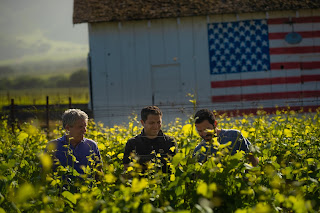
The Wine Write: The Santa Lucia Highlands is well known and respected by people in the know, but still flies a bit under the radar for most consumers. Do you see that changing?
Adam: We have the Santa Lucia Highlands Wine Artisans group collective. It's a collection of farmers and wineries in the region. Gwen McGill heads that organization. I think Gwen is doing a fantastic job in getting the word out. A lot of farmers here are trying to build up the reputation of the Santa Lucia Highlands. It's hard. There is a lot of time commitment. As Nick mentioned earlier, most of the people here are farmers at heart. There aren't many corporations down here. Most of us don't have a heck of a lot of time to dedicate towards a marketing effort. We are definitely trying to get the word out. I do think the critical scores we get help along the way. ROAR, Pisoni, Lucia, Bernardus, and some of the other wineries here have some nice restaurant placements. That helps, too.
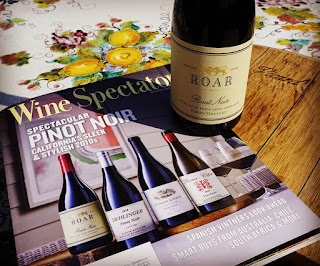
The Wine Write: Speaking of scores, ROAR has gotten critical acclaim from the start. Do you see those as a validation of what you do, or do you measure your success by other criteria?
Nick: A high critical score is a nice validation. Anyone who says that they are not is lying. We're all concerned with what other people think about our wines. A score provides some sense of how your wine is performing in relation to the many other wineries out there. That being said, our biggest indicator is whether our mom likes the wine or not! She's a tough critic. Our parents are the biggest lovers of ROAR wines. How we enjoy the wines is probably our most important test. When we taste them as a family at dinner, or share them with other people, we're probably our biggest critics. We are all very cognizant of how the wine is tasting at any time. That awareness is probably most acute at blending time. When we're putting together those final blends, we really assess very closely. We want to do our best to show what each vintage gave us.
Adam: Vintage to vintage is a huge factor. I determine each wine a success if I can't stop drinking it. If I taste a wine and am completely enthralled with it, I know we nailed it. Sometimes people tell me that they don't usually like Pinot Noir, but they loved ours. That spells success for me. I get a ton of satisfaction from hearing things like that. If we can convert someone not normally into wine or someone who's not normally a Pinot Noir fan, we've done our job. That's a success story. We make the wines to enjoy drinking them. When we reach other people in the same way, we get a lot of satisfaction. That's why we are doing this.
Nick: One last, quick point. This goes along with your question about style. We don't chase styles. We're not looking to be Burgundy, Oregon, Russian River, or the Sonoma Coast. You're your best self by showing what your site has to offer. We're focused on what we are producing here and making wines that we enjoy drinking. It's very important to us to make the best from what we have.
Adam: That's right. I dislike going into a winery and hearing that their wines are made in a Burgundian style when they're from the United States.
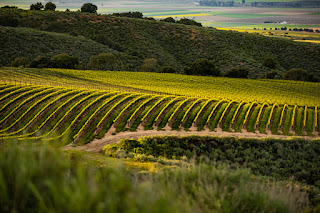 Sierra Mar Vineyard, planted 2007 - 2009
Sierra Mar Vineyard, planted 2007 - 2009
The Wine Write: What's the most common question you get from guests?
Nick: We're often asked which vineyard is our favorite. That's a tough question. For us, it depends on the vintage. In 2016 it was Soberanes. In 2017 Sierra Mar led the way. In 2018 we most liked Pisoni Vineyard. Rosella's Vineyard was our most liked ranch in 2019. Every year is different. We never try to change what each vineyard is giving us. For whatever reason, one of them turns out to be the best within the lineup that vintage. We never have a straight answer to that question. In any given vintage one can be better than another, but we're always trying to do our best with each vineyard.
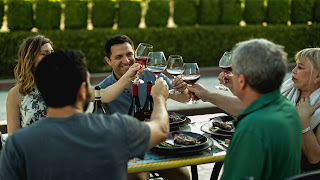
The Wine Write: There aren't that many fourth generation farming families in this country any more. How meaningful is that designation to you?
Adam: It's very meaningful to me. I did harvests in South Africa and New Zealand some years back now. I worked with a lot of French winemakers there. It was really cool to see how many generations some of those families go back. They've been doing it forever. That inspired me. Nick and I want to keep that going here. We're not looking to sell the winery off or looking at it as a monetary investment. We view it as a family heritage. Hopefully our children and grandchildren will follow us. We'd like to be known as good stewards of the land.
Nick: That was well put. It's as simple as wanting to carry on the family tradition. When you are a little kid, you don't appreciate the importance of land. As you get older, you gain an affinity for a place and recognize how cool it is to own this big property. That fact sets you into your roots really well. I've gained more and more appreciation over the past several years for what we have. You typically get out what you put in with farming. We're all very much invested in that sense. Adam and I are incredibly fortunate to have been born into this family. In a way it becomes a responsibility for us to carry this on. Ideally we'll transfer that responsibility to our kids one day, and help them recognize the hard work and diligence that goes into owning a property like this. Part of that is sustainability. We are always looking for ways to be sustainable with our farming practices. We can't control things like rainfall or wildfires, but we really put our minds to subjects like family, tradition, and legacy.
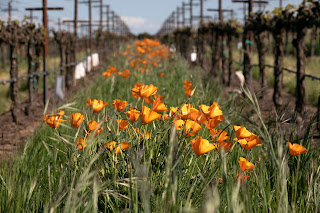
It's apparent that the future of the Franscioni properties and that of ROAR Wines are in good hands. Adam and Nick Franscioni are both appreciative of the work their parents have done to get them here, and passionate about the future prospects of the family business.
When one thinks about those prospects, it becomes clear that what is past is prologue. ROAR Wines was well received from the get go. The brand is considered among the best that the Santa Lucia Highlands has to offer. Wine critics from Robert Parker to Jeb Dunnuck to Kim Marcus to Matt Kettman have sung the praises of the wines for years. The wines make regular appearances on various Top 100 lists. More importantly, Rosella Franscioni loves them, as do multitudes of loyal customers. With a continued emphasis on diligent, caring, sustainable farming, why would anything change?
That sentiment also holds true for the Santa Lucia Highlands as a whole. It's a fascinating area, but one sometimes overlooked in the context of wine travel. As Adam Franscioni mentioned, almost all of the wineries of the region are run by family farmers. The focus is on growing quality fruit. That shows in the wines. It's worth a detour to view the appellation and visit these wineries. Both the Santa Lucia Highlands Wine Artisans website and that of the River Road Wine Trail are excellent starting points for planning a trip.
It's a feel good story when the next generation follows in the family's footsteps. We can't wait to see what the future holds for ROAR Wines and the Franscioni family. Imagine what two graduates from the University of Gary Franscioni could do!